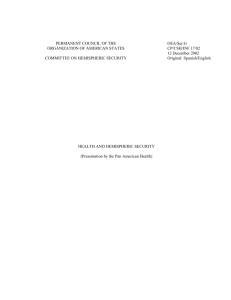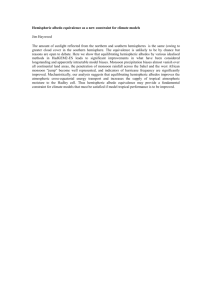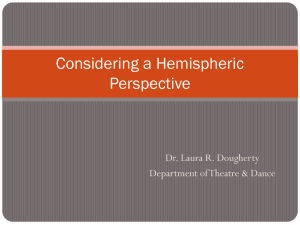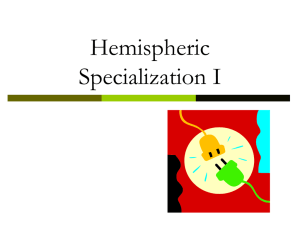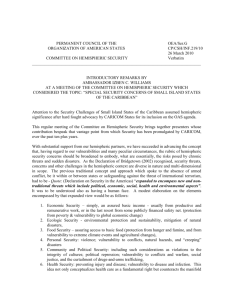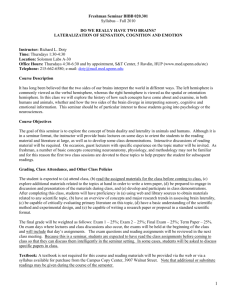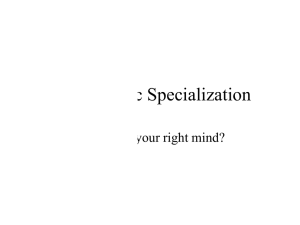Brain Asymmetry
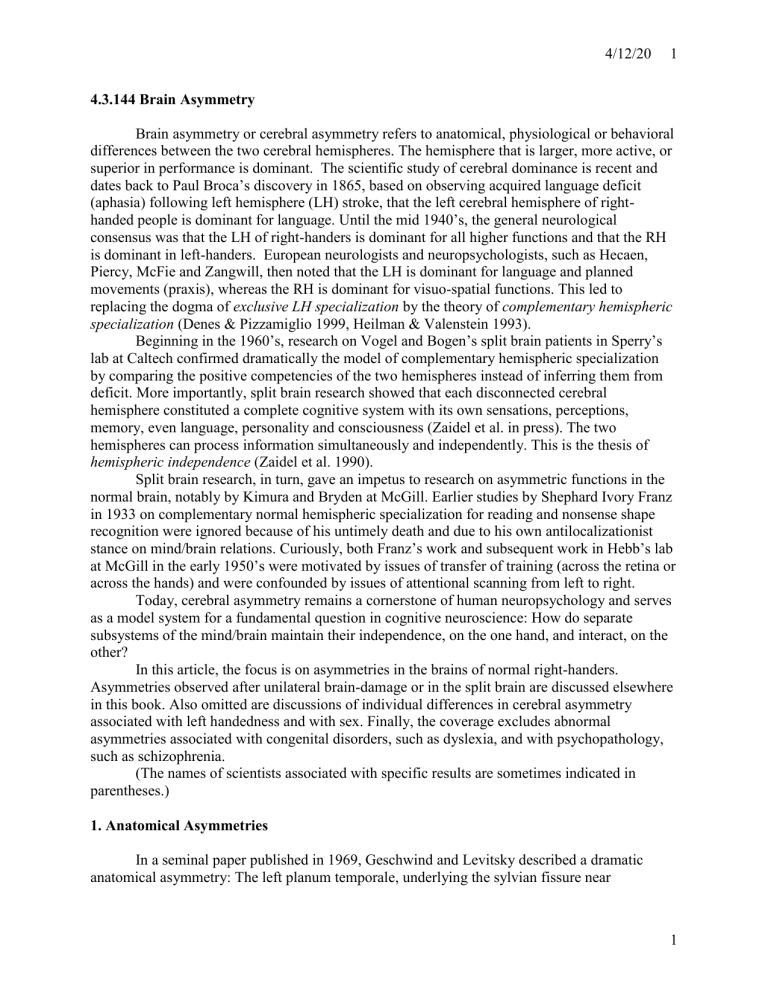
4/12/20 1
4.3.144 Brain Asymmetry
Brain asymmetry or cerebral asymmetry refers to anatomical, physiological or behavioral differences between the two cerebral hemispheres. The hemisphere that is larger, more active, or superior in performance is dominant. The scientific study of cerebral dominance is recent and dates back to Paul Broca’s discovery in 1865, based on observing acquired language deficit
(aphasia) following left hemisphere (LH) stroke, that the left cerebral hemisphere of righthanded people is dominant for language. Until the mid 1940’s, the general neurological consensus was that the LH of right-handers is dominant for all higher functions and that the RH is dominant in left-handers. European neurologists and neuropsychologists, such as Hecaen,
Piercy, McFie and Zangwill, then noted that the LH is dominant for language and planned movements (praxis), whereas the RH is dominant for visuo-spatial functions. This led to replacing the dogma of exclusive LH specialization by the theory of complementary hemispheric specialization (Denes & Pizzamiglio 1999, Heilman & Valenstein 1993).
Beginning in the 1960’s, research on Vogel and Bogen’s split brain patients in Sperry’s lab at Caltech confirmed dramatically the model of complementary hemispheric specialization by comparing the positive competencies of the two hemispheres instead of inferring them from deficit. More importantly, split brain research showed that each disconnected cerebral hemisphere constituted a complete cognitive system with its own sensations, perceptions, memory, even language, personality and consciousness (Zaidel et al. in press). The two hemispheres can process information simultaneously and independently. This is the thesis of hemispheric independence (Zaidel et al. 1990).
Split brain research, in turn, gave an impetus to research on asymmetric functions in the normal brain, notably by Kimura and Bryden at McGill. Earlier studies by Shephard Ivory Franz in 1933 on complementary normal hemispheric specialization for reading and nonsense shape recognition were ignored because of his untimely death and due to his own antilocalizationist stance on mind/brain relations. Curiously, both Franz’s work and subsequent work in Hebb’s lab at McGill in the early 1950’s were motivated by issues of transfer of training (across the retina or across the hands) and were confounded by issues of attentional scanning from left to right.
Today, cerebral asymmetry remains a cornerstone of human neuropsychology and serves as a model system for a fundamental question in cognitive neuroscience: How do separate subsystems of the mind/brain maintain their independence, on the one hand, and interact, on the other?
In this article, the focus is on asymmetries in the brains of normal right-handers.
Asymmetries observed after unilateral brain-damage or in the split brain are discussed elsewhere in this book. Also omitted are discussions of individual differences in cerebral asymmetry associated with left handedness and with sex. Finally, the coverage excludes abnormal asymmetries associated with congenital disorders, such as dyslexia, and with psychopathology, such as schizophrenia.
(The names of scientists associated with specific results are sometimes indicated in parentheses.)
1. Anatomical Asymmetries
In a seminal paper published in 1969, Geschwind and Levitsky described a dramatic anatomical asymmetry: The left planum temporale, underlying the sylvian fissure near
1
4/12/20 2
Wernicke’s area, was larger than the right in 70% (really 80%) of right handers.
Correspondingly, the sylvian fissure is larger on the left in 70% of right-handers and this is said to be associated with LH specialization for language. The association is imprecise: Lesion studies suggest that about 98% of right-handers have language specialized in the LH. A similar anatomical asymmetry is already present in the fetus by 31 weeks of gestation. These asymmetries occur whether the area is defined by anatomical landmarks or cytoarchitectonically.
They appear to be reduced in left handers. Lesion, PET and fMRI studies suggest that planum temporale asymmetry is related to phonological decoding and auditory comprehension.
Geschwind and Galaburda also found that pars opercularis (Broca’s area) is larger on the left. More grossly, the frontal region is wider and larger in the RH whereas the occipital region is wider and larger in the LH.
Scheibel described an asymmetry in dendritic organization in the left and right operculum: Higher order dendritic branching was greater on the left, whereas lower order dendritic branches were longer on the right. This was attributed to quicker early RH development but greater LH development after the first year of life. This dynamic epigenetic pattern of changing histological asymmetries contrasts with the stable gross asymmetries described above.
2. Neurochemical Asymmetries
The neurotransmitter dopamine is involved with control of motor behavior and higher integrative functions, and is lateralized to the LH. By contrast, noradrenergic innervation and the neurotransmitters norepinephrine, as well as serotonin, are associated with up regulation and down regulation of autonomic and psychological arousal, respectively, and are lateralized to the
RH. This is said to confer LH dominance to the “activation” regulatory system, but RH dominance to the “arousal” regulatory system (Tucker). Activation refers to “readiness for action”, and leads to motor functions. Arousal refers to “ orientation to input stimuli” and leads to attentional control. These, in turn, are conjectured to determine hemispheric specialization for perception, action, emotion and cognition.
There are also asymmetries in neuroendocrine activity. Thus, there is asymmetry in cerebral control of cortisol secretion during emotional situations (Wittling in Davidson &
Hugdahl 1995). There is also asymmetry in neuroimmunologic activity. LH activation seems to be immunoenhancing, whereas RH activation is immunosuppressive (Kang, Amassian).
Fluctuating levels of steroid hormones, such as changes of estrogen during the menstrual cycle, may affect LH function by modulating regional dopamine and other catecholamines. The corpus callosum is further believed to mediate dopaminergic asymmetry. Thus, increased callosal function may be associated with reduced dopaminergic, and consequently functional, asymmetry. It is therefore postulated that stable steroid hormones, notably testosterone, affect the organization of hemispheric asymmetry prenatally, whereas fluctuating hormones, notably estrogen, affect the activation of neurotransmitter tracts and selectively change callosal function
(Weekes).
Asymmetries in brain receptors, such as nicotinic acetylcholinergic receptors, may underlie asymmetric hemispheric activation, predominantly on the right, during uptake of recreational drugs, including alcohol, caffeine, and especially nicotine. Asymmetric hemispheric effects have also been shown for pharmacological agents, such as lithium bicarbonate, methylphenidate, and chlorpromazine. This is important for biological psychiatry. For example,
2
4/12/20 3 changes in behavioral hemispheric asymmetry following floxetine treatment successfully predicts therapeutic response in depression (Bruder).
3. Physiological Asymmetries
3.1. PET and fMRI
These techniques measure hemodynamic response and have a good spatial resolution (~
4mm) but poor temporal resolution (several seconds). Cabeza & Nyberg (2000) provide a valuable review of imaging during cognition. In general, these studies display bilateral activations that contrast with the asymmetric effect of lateralized lesions.
Attention : Sustained attention (vigilance) tasks yield prefrontal and parietal activation, preferentially in the RH. Spatial compatibility (Stroop) tasks selectively engage the anterior cingulate and left prefrontal cortex. Orienting of visuospatial attention selectively engages right posterior parietal cortex. Divided attention tasks selectively activate left prefrontal cortex. Thus, attention involves a bilaterally distributed network whose components are lateralized to one or the other hemisphere.
Motor : Unimanual choice reaction time selectively activates left prefrontal-intraparietal areas compared to simple reaction time, consistent with LH specialization for action (Schultera).
Spatial compatibility tasks activate dorsal premotor and superior parietal areas, predominantly on the left (Iacoboni). Imitation of hand movements (Iacoboni) and of object manipulation
(Buccino) activate bilateral inferior frontal areas, more on the left, and bilateral parietal areas, more on the right (mirror neurons).
Perception : Perception of objects and faces activates the same ventral pathway but there is greater right lateralization for faces than for objects. Perception of smell activates olfactory orbitofrontal cortex, especially on the right. Right occipitotemporal (fusiform) cortex is selectively involved in processing specific visual form information (same view of same object), whereas the left is more involved in processing categorical information (different exemplars).
Music perception engages right superior temporal cortex for melodies, but left Broca’s area/ insula for rhythms. Recognition of pictures of self selectively activates right prefrontal cortex.
Imagery : Generation of images from words activates left inferior posterior temporal lobe, although more complex visual imagery selectively engages right temporal cortex. Imagery of maps engages right superior occipital cortex, whereas mental navigation engages the left middle occipital gyrus.
Language : Spoken word comprehension activates bilateral medial and superior temporal gyrus but activation during written word recognition is left lateralized. Surprisingly, left prefrontal cortex is activated equally during written word recognition with or without spoken responses. Written words also selectively activate left posterior temporal cortex. There is a progression of hemispheric specialization: Feature conjunction in letters occurs in medial extrastriate cortex contralateral to the stimulus visual field (VF). Letter shapes activate posterior fusiform gyrus opposite the processing hemisphere, whereas letter names activate anterior and
3
4/12/20 4 posterior fusiform gyrus bilaterally (Pollmann). Letter strings activate left posterior fusiform area, whereas legal words (visual word forms) activate left anterior fusiform area with stimuli in either VF (Cohen). Lexical access via the visual word form activates the posterior temporal lobe bilaterally, whereas phonological recoding activates a left-lateralized network of posterior
(fusiform gyrus, presumably involved in sub-lexical graphemic processing) and anterior (inferior frontal gyrus, presumably involved in phonological recoding) structures (Indefrey). This supports the “hemispheric dual rout model”: Both hemispheres have lexical routes (“sight reading”), but only the LH has a nonlexical (“phonetic”) route.
Deaf native users of American Sign Language show normal LH activation during language processing. In addition, they show recruitment of RH fronto-temporal-parietal regions presumably for processing location and motion information present in ASL. This RH recruitment may be subject to a critical period (Neville).
Listening for the moral of a fable selectively activated frontal and temporal regions of the
RH.
Memory : The phonological loop component of working memory distinguishes between a phonological store, associated with left parietal activation, and a rehearsal buffer, associated with activation in Broca’s area. Working memory engages prefrontal and parietal regions. These are lateralized by type of material: Broca’s area and left parietal areas are activated for verbal/numerical tasks; activations for nonverbal material tend to be bilateral.
Tulving’s hemispheric encoding/retrieval asymmetry (HERA) model posits that (1) the left prefrontal cortex is selectively involved in semantic memory retrieval, (2) the left prefrontal cortex is selectively involved with episodic memory encoding (personally experienced past events), and (3) the right prefrontal cortex is selectively involved in episodic memory retrieval.
However, recent data show material-specific laterality: LH activation during both encoding and retrieval of words, and RH activation during both encoding and retrieval for patterns, faces, scenes, or nonverbal sounds.
Different semantic domains engage different cortical regions. For example, retrieval of animal information engages left occipital regions, perhaps reflecting processing of physical features, whereas retrieval of tool information engages left prefrontal regions, perhaps reflecting processing of linguistic or motor information. Similarly, generating action words engages left temporo-occipital regions, close to motion perception regions. In other words, knowledge about object attributes appears to be stored close to the regions involved in perceiving those attributes.
There may be a dissociation in right prefrontal cortex between dorsal cortex, associated with free recall, and ventrolateral cortex, associated with cued recall (Fletcher). Finally, autobiographical retrieval is associated with activation in a right fronto-temporal network.
Emotions : Activation during perception of different emotions converges in the left prefrontal cortex. Dolan (in Gazzaniga 2000) reports lateralized right amygdala activation during masked (unconscious) presentation of conditioned fearful faces, but left lateralized amygdala activation during unmasked (conscious) presentation.
3.2. The electroencephalogram (EEG)
The EEG has a good temporal resolution but poor spatial resolution and, therefore, it provides a relatively crude measure of hemispheric asymmetry. It is now beginning to be used
4
4/12/20 5 together with imaging techniques like fMRI, that have a good spatial resolution but poor temporal resolution. EEG measures tend to focus on ongoing changes in the frequency domain whereas event-related potential (ERP) measures focus on stimulus-yoked changes in the voltage wave pattern over a second or so. Different frequency ranges of the EEG have different functional significance. Early work by Galin and Ornstein in the 1970’s focused on the band
(8-12 cycles per second or Hz), whose power is inversely related to cognitive engagement. They found a larger right-to-left power ratio during verbal (LH) tasks and a smaller ratio during spatial
(RH) tasks. They also found differential stable asymmetries in different professionals, lawyers with larger R/L ratios (more LH activity), and artists with larger L/R ratios (more RH activity).
More recently, focus has shifted to asymmetries in higher frequency bands of the EEG.
For example, the gamma band (25-35 Hz) showed a dissociation between word and nonword reading or listening in the LH but not in the RH (Lutzenbeger, Pullvermuller). Also promising, are measures of intrahemispheric and interhemispheric connectivity and coherence from large
(128) electrode arrays that permit better spatial localization and provide indices of network dynamics during cognition (Gevins).
Davidson (in Davidson & Hugdahl 1995) used EEG measures of suppression to characterize anterior hemispheric emotional asymmetries and individual differences in emotional reactivity, mood and temperament. Approach-related positive affect was associated with left anterior activation, whereas withdrawal-related negative affect was associated with right anterior activation.
3.3 Event Related Potentials (ERP)
Separate components of the ERP are associated with semantic and syntactic components of post lexical integration in language comprehension (Brown et al. in Gazzaniga 2000). The left perisylvian area is critical for syntactic processing, as well as for aspects of higher order semantic processing. Within 200 msec after stimulation, processes related to lexical meaning and integration emerge in the ERP waveform. (1) A transient negativity over left anterior electrode sites (left anterior negativity, LAN) emerges 200-500 msec after word onset. The LAN is associated with initial parsing and processing of syntactic word category information. (2) A transient bilateral negativity (N400) develops between 200 and 600 msec after word onset. The
N400 is associated with contextual effects of semantic processing (e.g., semantic unexpectedness of a noun in a sentence or discourse). (3) A transient bilateral positivity develops between 500 and 700 msec, called the syntactic positive shift (SPS) or the P600, and is associated with syntactic correction operations, such as arise from syntactic violations. (4) A slow positive shift over the front of the brain develops across the sentence, and is associated with its overall meaning. The slow shift has separate left and right lateralized components.
Anterior LH specialization for grammar but not for semantics normally develops at age
36-42 months and is absent in later language acquisition (Neville).
3.4. Psychophysiological Asymmetries
Consistent with the thesis of hemispheric independence, brain asymmetry applies to cognition, emotion, and regulation of autonomic physiological processes.
Neurotransmitter, neuroendocrine, immunomodulatory, cardiovascular, and electrodermal activity, skin temperature, and vasomotor activity are all asymmetric.
5
4/12/20 6
Neural control of cardiovascular function is lateralized. Peripheral autonomic chronotopic control of cardiac activity (heart rate) is controlled by right-lateralized sympathetic and parasympathetic pathways. By contrast, AV conduction and cardiac contractivity are leftlateralized. Emotional stimuli in the LVF, yield larger heart rate and blood pulse volume changes than stimuli in the RVF (Wittling, Spence). These peripheral asymmetries are not associated with corresponding cognitive asymmetries. Finally, there may be an asymmetry in pain sensitivity, greater in the RH.
In sum, the LH appears to specialize for motor functions and in the regulation of the body’s defense against invading agents, whereas the RH appears specialized for control of vital functions supporting survival and coping with stress.
4. Behavioral Asymmetries
4.1. Models of Behavioral Asymmetry
Behavioral asymmetries, or laterality effects, in the normal brain are measured by restricting input stimuli or behavioral responses or both to one sensory or motor side. By far the most common experimental paradigm is hemifield tachistoscopy with unimanual responses.
Stimuli are flashed for less than 180 msec to one visual hemifield (projecting to the opposite hemisphere) to prevent involuntary saccades towards the stimulus, and response choices are signaled by different fingers of one hand, again controlled by the opposite hemisphere. For the sake of simplicity, the following methodological discussion refers to a hemifield experiment, but similar comments apply to experiments in other modalities.
Split brain research motivates two limited case models of behavioral laterality effects in the normal brain. The first is the exclusive specialization model, where only one hemisphere, say the LH, can process the stimuli, so that stimuli in the left visual field (LVF) must be relayed from the RH to the LH through the corpus callosum prior to stimulus processing. This model is called the callosal relay (CR) model. The second is the relative specialization, or hemispheric independence (of representation and strategy) model, where each hemisphere can process the stimuli, though usually not equally well, and the input VF determines the processing hemisphere.
This is called the direct access (DA) model. Consider the example of a lateralized lexical decision task with orthographically legal nonwords and unimanual word/nonword responses. A callosal relay model predicts a main effect of input VF (RVF advantage or RFVA) as well as a main effect of an independent stimulus variable (say, wordness) but no significant interaction between the two (assuming that words and nonwords are equally complex and equally susceptible to delay or degradation in callosal relay). By contrast, a main effect of VF (RVFA) and a significant interaction of VF and an independent variable, say wordness, implies that the
DA model holds.
Some behavioral laterality tasks, like phonetic perception in dichotic listening to nonsense consonant-vowel (CV) syllables, are CR, exclusively specialized in the LH.
Surprisingly many, like lateralized lexical decision, are DA. For reasons still unclear, it appears that the VF of the target, rather than the response hand, determines the hemisphere in control of processing. Even when DA obtains, there may be implicit interhemispheric priming effects and resource borrowing, leading to the concept of “degrees of hemispheric independence”. Many tasks probably engage both DA and CR components (Zaidel).
6
4/12/20 7
4.2. Methodology
Signal detection.
For reasons still unclear, behavioral laterality effects are more likely to occur with accuracy than with latency as the dependent variable. The signal detection measure of bias, , often shows a more negative bias in the LVF than in the RVF. A speed-accuracy tradeoff analysis of some DA tasks suggests that the two hemispheres have similar speed-sensitivity functions, suggesting similar decision strategies, but different speed-bias functions, implying hemispheric differences at the response choice stage. This highlights the need to apply signal detection measures to behavioral laterality experiments. That is rarely done.
Previous trial effects.
Common laterality tests show previous trial effects involving the correctness, the VF and the target identity of the previous trial. They exhibit a selective implicit
RH error monitoring, and same-VF or same-target priming effects across trials, indicating the importance of context effects and the ubiquitousness of hemispheric momentum effects in time.
Bilaterality effect.
Bilateral displays, with targets in one VF and distractors in the other, increase hemispheric independence and the behavioral asymmetry (Boles).
Reliability and validity.
This is a sorely neglected topic. A standard measure of the laterality index is (L-R)/(L+R), where L = accuracy in the LVF, etc. Voyer (1998) carried out a meta-analysis of 88 experiments and found an average test-retest or split-half reliability of the laterality index of .68. Dichotic listening had greater reliabilities than VF studies, and auditory verbal tests had greater reliabilities than nonverbal tests. Verbal dichotic tests had an average reliability of .70. Dichotic listening to stop consonant-vowel (CV) syllable pairs showed the highest reliability, .80. Accuracy yielded higher reliabilities than latency. Number of items affected split-half but not test-retest reliability. Split-half reliabilities were higher than test-retest reliabilities. Extensive testing with dichotic CVs yielded reliabilities around .83 and testing with lateralized lexical decision including lateralized distractors yielded reliabilities around .81
(Zaidel).
The reliability of the difference between the two VF scores is maximized when they are negatively correlated with each other, but when each is based on a large number of trials that are positively intercorrelated. Indeed, the correlation between the two ear scores in dichotic listening varies from .1 to -.72 and the use of bilateral stimuli in VF studies reduces the correlation between the two VFs (Zaidel).
Voyer’s estimate of criterion validity from cross correlations of laterality measures between tests yielded a low validity of .26. However, the procedure assumed a true global measure of hemispheric specialization. This is unlikely. Different functions even within the same domain, such as language, are lateralized to different degrees. Thus, phonetic perception appears to be exclusively lateralized whereas visual and especially auditory word recognition are more bilaterally represented. Instead, one can use the split brain as establishing construct validity. By administering the same behavioral laterality tests to split and normal brains, it is possible to establish the underlying degree of lateralization of the relevant functions (Zaidel et al. 1990).
This procedure reveals that lateralized lexical decision measures relative hemispheric specialization, but dichotic listening to nonsense CV syllables is exclusively specialized in the
LH. Consequently, individual differences in the right ear advantage reveal individual differences in LH competence or in callosal relay (from RH to LH), or both.
7
4/12/20 8
Laterality and ability . There is another sorely neglected aspect of the validity of behavioral laterality tests: The degree to which lateralized performance predicts the underlying or associated ability in free vision. It is possible that a RVFA reflects better LH performance overall and thus better scores on any test predominantly controlled by the LH. This concept is captured by Levy’s individual differences in stable hemispheric arousal asymmetry. Such characteristic asymmetry is said to account for half of the variance in asymmetry scores across tasks, and it contributes more to asymmetry in tasks with bilateral stimuli. However, no relationship was found between characteristic arousal asymmetry and performance on various tests of cognitive ability.
The question remains whether performance in a lateralized version of a task predicts free vision performance on the same task? It does, but surprisingly weakly. For example, there was an unexpected RVFA in a test for recognizing facial emotions and a moderate correlation (r = .433) between the RVFA and performance on a free vision version of the test (Kee). In a lateralized lexical decision task, there was the expected RVFA but free vision measures of vocabulary correlated positively with accuracy in either VF (LVF: r =.524, RVF: r =.59), and reading comprehension correlated only with LVF accuracy (r = .385). Voyer also observed a positive correlation between the RVFA in a lateralized mental rotation test and free vision performance on a test of spatial ability. Since the correlations are relatively small, it is misleading to infer hemispheric specialization of a cognitive test from the VFA in a lateralized version of the same or a similar test.
4.3. Domains of Specialization
Consistent with the theory of hemispheric independence, hemispheric differences can occur at any level of information processing.
Attention . Hemispheric engagement by lateralized stimuli creates an activational bias to the opposite half of space and enhances processing of material in that location. Task demands, such as processing facial emotions, may selectively activate the specialized hemisphere. Clinical and imaging studies suggest that the RH is specialized for alerting, arousal and vigilance. Indeed, testing of covert orienting of spatial attention using the Posner paradigm discloses a greater cost for detecting LVF targets with invalid cues in the RVF than for detecting RVF targets with invalid cues in the LVF. There is some suggestion that the RVF shows selective sensitivity to object-based cueing, whereas the LVF is selectively sensitive to location-based cueing.
Perception . Older views held that hemispheric specialization is divided by modality, material, or stage of processing, with the LH specialized for auditory, verbal or output processing; the RH for visual, nonverbal or input processing. A more recent view is in terms of information processing styles: the LH is analytic and the RH is synthetic (Levy), and a related current view holds that the LH is local and the RH is global, e.g., in processing hierarchic patterns (Robertson). A more precise statement of the latter view is that the LH is specialized for processing relatively high spatial and temporal frequencies whereas the RH is specialized for relatively low frequencies, given the context (Sergent, Hellige, Christman, and See Ivry &
Robertson 1998). The evidence for hemispheric specialization in the normal brain, in terms of relative frequencies, is still controversial, and the evidence from normals for hemispheric
8
4/12/20 9 specialization in global/local processing is weak. The global/local hemispheric dissociation has better support from neuroimaging studies in normals and from behavioral studies in hemispheredamaged patients.
The RH is said to be specialized for processing facial emotions and emotional prosody. In space localization, the LH is said to be specialized for processing categorical relations, such as on-off, inside/outside, above/below, or near/far; the RH is said to be specialized for coordinate, metric relations (Kosslyn). The claim appeals to selective RH involvement in magnocellular vision (Livingstone), still a controversial view. The claim received mixed empirical support
(Hellige 1993, Sergent).
Imagery . The componential theory of visual imagery (Kosslyn) distinguishes image generation, maintenance, scanning, and transformation. There is controversial evidence for LH specialization for image generation (Farah) and for RH specialization in image rotation
(Sergent). Kosslyn believes that categorical image generation (by description of parts) is specialized in the LH, whereas image generation by stored metric memories is specialized in the
RH.
Emotions . There is a LVFA (RH specialization) for recognizing and, perhaps, expressing facial emotions, as well as emotional intonation and emotional gestures. The RH may have a selective role in expressing negative emotions and the LH in expressing positive ones. Heller (in
Banich & Heller 1998) distinguishes emotional valence (pleasant, unpleasant), controlled by anterior cortical regions, (pleasant more on the left, unpleasant more on the right), from emotional arousal (high, low) controlled by right posterior regions. Heller also distinguishes two groups of individuals with high trait anxiety: Those with anxious apprehension (worry), and increased LH EEG activation ( suppression), and those with anxious arousal (panic), and increased RH activation. Pettigrew believes that bipolar disorder is the result of a slow interhemispheric switching mechanism that becomes stuck on the left (mania) or on the right
(depression).
Language.
Findings from neurological patients guide the design and interpretation of behavioral laterality experiments in normal subjects: the anterior LH is specialized for phonology and syntax, more posterior (temporal) language areas in the LH control semantics, and the RH is specialized for pragmatics.
Dichotic listening studies suggest that phonetic perception (e.g., distinguishing stop consonant-vowel syllables by place of articulation and voicing) is specialized in the LH (Zaidel).
Ivry finds that the perception of voice onset time is specialized in the RH, whereas the perception of place of articulation is specialized in the LH, because voicing is carried by low speech frequencies and place is carried by high frequencies.
Word repetition priming is case- and font-sensitive in the LVF but not in the RVF
(Marsolek) and the word superiority effect (detecting a letter is faster in a word than in a nonsense string) is greater in the RVF, suggesting that word recognition in the LH is quicker and deeper. However, format distortion, e.g., aLtErNaTiNg case or vertical presentations, selectively impairs word recognition in the RVF, more for words than for nonwords (Zaidel, Arguin), suggesting a selective contribution of pattern recognition to word recognition in the LH. Word length can affect word recognition in both hemispheres, more in the RH than in the LH. Both hemispheres show comparable word frequency effects, but the LH shows a selective word
9
4/12/20 10 regularity effect (better recognition of words with regular than with exceptional spelling-tosound correspondence). The preceding observations are consistent with the view that both hemispheres can recognize words via a lexical route (“sight vocabulary”) but that the LH has selective access to a nonlexical route (spelling-to-sound, “phonics”). However, when taxed, the
RH does show regularity effects, suggesting that it has latent competence for spelling-to-sound conversion.
When we fixate during reading, we look ahead, thus selectively attending to the RVF in
English (read left-to-right), but to the LVF in Arabic (read right-to-left). Indeed, hemifield tachistoscopic studies show that while both types of languages are specialized in the LH, early visual stages of word recognition engage the RH more in Farsi than in English (Melamed).
Semantic priming experiments suggest that the RH activates automatically more distant semantic relationships and multiple meanings of ambiguous words (Beeman, Chiarello,
Burgess). The LH may be more specialized for function words (closed class items) than for content (open class items). Sentences are more effective primes for the LH than for the RH
(Faust), showing that the LH is selectively specialized for syntax. Still, both hemispheres show sensitivity to grammatical agreement (Zaidel, Chiarello), suggesting that the RH does have some grammatical competence. Finally, RH activation of multiple distant meanings may help it make predictive inferences in discourse, especially when breaks in coherence occur (Beeman).
Based on lateralized priming experiments, Chiarello concluded that lexical orthographic relationships are more available to the RH, phonological relationships are more available to the
LH, and semantic relationships are available to both. Automatic lexical semantics is more available to the RH, whereas controlled, strategic lexical semantics is more available to the LH.
Olfaction. Unlike vision, hearing, and somesthesis, the olfactory system is mainly uncrossed: left nostril LH, right nostril RH. Studies of normal subjects suggest that the olfactory thresholds of the two hemispheres are the same. Odor discrimination and intensity judgments show an advantage in the right nostril (RH), but odor naming shows a left nostril superiority. However, results are inconsistent and behavioral imaging and lesion studies reach conflicting conclusions. Nonetheless, there is agreement that interhemispheric interaction is critical for olfaction: birhinal presentation (both nostrils) increases perceived odor intensity and facilitates odor naming, although it does not affect detection thresholds (Doty).
5. Convergence
There are systematic discrepancies between profiles of hemispheric specialization observed in the normal brain (reviewed here, Bradshaw & Nettleton 1983, Bryden 1982), in the split brain (e.g., Zaidel et al. in press), and in hemisphere-damaged patients (Denes &
Pizzamiglio 1999, Heilman & Valenstein 1993). Laterality effects are typically smallest in the former and largest in the latter. Thus, unilateral lesions can lead to devastating cognitive deficits not mirrored in the disconnected, let alone the normal, hemispheres (Benson & Zaidel 1985). For example, large perisylvian LH lesions can lead to global aphasia and yet the disconnected RH is neither word deaf nor word blind. Similarly, right posterior lesions can lead to neglect of the left half of space and denial of illness (anosognosia) and yet the disconnected LH does not exhibit neglect or denial. In general, it seems that unilateral lesions incorporate loss of function in diseased tissue, diaschisis, and pathological inhibition of residual competence in the healthy hemisphere. Those effects are minimized in the split brain and absent in the normal brain.
10
4/12/20 11
Consequently, the disconnected hemispheres exhibit greater functional competence than inferred from lesion studies. The normal hemispheres, in turn, evince even greater competence than the disconnected hemispheres, presumably because they can borrow resources from each other even when they process information independently.
Hemispheric representation for language is illustrative. Phonological and syntactic deficit follow exclusively LH lesions, semantic deficits follow predominantly LH lesions and pragmatic deficits follow predominantly RH lesions. But the disconnected RH has substantial auditory language comprehension, including some grammar, a modicum of lexical (but not sublexical) reading, and on occasion even some speech (Zaidel et al. in press). Consequently, appeal is often made to RH language in trying to account for perplexing symptoms in aphasic syndromes, including covert reading in pure alexia, semantic errors in deep dyslexia or good miming in the presence of misnaming written words in optic aphasia. The normal brain suggests that RH language competence is even richer, including grapheme-phoneme correspondence. The challenge for future research is to release latent RH language capacities for clinical recovery in aphasia, and to modulate degree of hemispheric specialization in the normal brain for cognitive optimization.
11
4/12/20 12
Bibliography
Banich M T, Heller W (eds.) 1998 Evolving perspectives on lateralization of function. Current
Directions in Psychological Science. 7 : 1-37
Benson D F, Zaidel E (eds.) 1985 The Dual Brain: Hemispheric Specialization in Humans .
Guilford, NY
Bradshaw J L, Nettleton N (eds.) 1983 Human Cerebral Asymmetry . Prentice Hall, Englewood
Cliffs, NJ
Bryden M P 1982 Laterality: Functional Asymmetry in the Intact Brain . Academic Press, New
York
Cabeza R, Nyberg L 2000 Imaging Cognition II: An empirical review of 275 PET and fMRI studies. Journal of Cognitive Neuroscience 12 : 1-47
Davidson J, Hugdahl K (eds.) 1995 Brain Asymmetry . MIT Press, MA
Denes G, Pizzamiglio L (eds.) 1999 Handbook of Clinical and Experimental Neuropsychology .
Psychology Press, Sussex, UK
Gazzaniga M S (ed.) 2000 The New Cognitive Neurosciences . MIT Press, MA
Heilman K M, Valenstein E (eds.) 1993 Clinical Neuropsychology, 3rd Edition . New York,
Oxford University Press.
Hellige J B, 1993 Hemispheric Asymmetry: What’s Right What’s Left?
Harvard University Press,
Cambridge, MA
Ivry R B, Robertson LC 1998 The Two Sides of Perception . MIT Press, MA
Zaidel E Clarke J M & Suyenobu B 1990 Hemispheric independence: A paradigm case for cognitive neuroscience. In A B Scheibel and A F Wechsler (eds.), Neurobiology of Higher
Cognitive Function pp. 297-355. Guilford Press, NY
Zaidel E, Iacoboni M, Zaidel DW, Berman SM, Bogen, JE in press. Callosal syndromes. In K M
Heilman & E Valenstein, (eds.) Clinical Neuropsychology, 4th Edition . New York, Oxford
University Press.
Eran Zaidel
Psychology
UCLA
Los Angeles, CA 90095-1563
USA.
E-mail: ezaidel@psych.ucla.edu
12
Telephone: (310) 825-4343
Fax: (310) 206-3655
4/12/20 13
13
